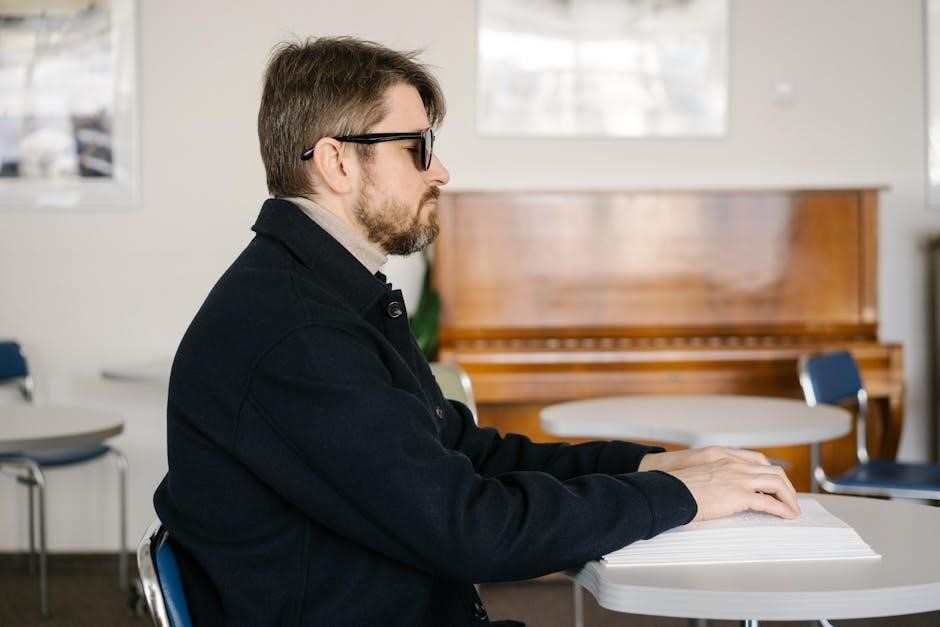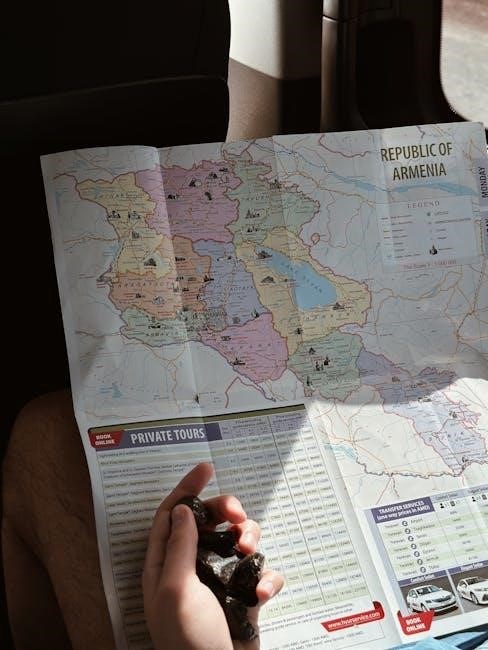Sighted guiding is a vital assistance method where a visually impaired individual is guided by a sighted person‚ enabling safe mobility and participation in daily activities․ The primary purpose is to provide clear communication and directional support‚ fostering independence and confidence․ This collaborative approach relies on trust‚ effective techniques‚ and mutual understanding to navigate various environments successfully․
What is a Sighted Guide?
A sighted guide is an individual who assists a visually impaired person by providing verbal cues and physical guidance to navigate environments safely and efficiently․ The role involves offering clear directions‚ describing surroundings‚ and helping the individual avoid obstacles․ A sighted guide acts as a mobility aid‚ enabling the visually impaired person to move confidently in various settings‚ from familiar spaces like homes to complex environments like public transportation or crowded areas․ The guide’s primary focus is to convey essential information while respecting the individual’s autonomy and preferences․ This partnership requires strong communication skills‚ spatial awareness‚ and a patient‚ empathetic approach to ensure seamless collaboration․
The Importance of Sighted Guides for Visually Impaired Individuals
Sighted guides play a crucial role in empowering visually impaired individuals to navigate the world independently․ By providing descriptive information about surroundings‚ they enable safe and efficient movement‚ reducing the risk of accidents․ This assistance extends beyond physical navigation‚ offering emotional support and boosting confidence in unfamiliar or challenging environments․ Sighted guides also facilitate social interactions and access to essential services‚ ensuring full participation in daily life․ Their role is indispensable in bridging the gap between visual and non-visual experiences‚ fostering inclusivity and equality․ Without sighted guides‚ many visually impaired individuals would face significant barriers to living fulfilling and independent lives․
Key Roles and Responsibilities of a Sighted Guide
A sighted guide’s primary role is to assist visually impaired individuals by providing clear‚ descriptive information about their surroundings․ This includes identifying obstacles‚ navigating paths‚ and communicating environmental changes․ Guides must maintain a steady pace‚ offer verbal cues‚ and ensure safe movement․ They are also responsible for building trust and confidence‚ respecting the individual’s independence‚ and adapting to their unique needs․ Effective communication is essential‚ as is staying alert to potential hazards․ Sighted guides should remain patient‚ empathetic‚ and proactive‚ continuously learning to improve their assistance techniques․ Their responsibilities extend to fostering a sense of security and independence‚ enabling visually impaired individuals to engage fully with their environment․

Techniques and Best Practices for Sighted Guides
Effective sighted guiding involves clear communication‚ maintaining a steady pace‚ and using verbal cues to describe surroundings․ Guides should stay alert to potential hazards and adapt to individual needs․
Effective Communication Strategies
Clear and concise communication is essential for effective sighted guiding․ Guides should use descriptive language to outline surroundings‚ such as obstacle locations or changes in terrain․ Verbal cues‚ like “step up ahead” or “narrowing path‚” help the visually impaired individual navigate safely․ Active listening is crucial; guides should confirm understanding and adjust their communication style to meet the individual’s preferences․ Regular check-ins ensure both parties are aligned and comfortable․ Using a calm and confident tone fosters trust‚ while avoiding vague terms ensures clarity․ These strategies enable seamless collaboration and empower visually impaired individuals to move independently with assurance․
Proper Movement and Navigation Techniques
Proper movement and navigation are critical for effective sighted guiding․ Guides should maintain a steady pace‚ allowing the visually impaired individual to follow comfortably․ Verbal cues‚ such as “step up” or “narrow path ahead‚” help navigate obstacles․ Physical guidance‚ like offering an arm‚ provides additional support while maintaining independence․ Guides should stay alert to the environment‚ identifying hazards like uneven surfaces or low-hanging objects․ Clear instructions ensure smooth transitions‚ such as stopping or changing direction․ The goal is to facilitate seamless movement‚ enabling the individual to navigate safely and confidently in any setting․ These techniques require patience‚ awareness‚ and adaptability to meet the unique needs of the visually impaired person․
Environmental Awareness and Obstacle Identification
Environmental awareness is a cornerstone of effective sighted guiding‚ ensuring the visually impaired individual navigates safely․ Guides must actively scan the surroundings to identify potential obstacles such as furniture‚ stairs‚ or uneven surfaces․ Verbal cues like “step down” or “object to your left” are essential for clear communication․ Physical guidance‚ such as gently steering the person away from hazards‚ can also be used․ The guide should remain vigilant‚ adapting to dynamic environments like crowded spaces or construction zones․ By anticipating and addressing obstacles proactively‚ the guide enables seamless navigation‚ fostering confidence and independence for the visually impaired person․ This awareness is critical for ensuring safety and ease of movement in any setting․

Challenges and Considerations for Sighted Guides
Sighted guides face challenges like building trust‚ navigating unfamiliar environments‚ and balancing assistance with independence․ Patience‚ adaptability‚ and clear communication are essential to ensure safe and effective support․
Building Trust and Confidence with the Visually Impaired
Building trust and confidence is crucial for effective sighted guiding․ Clear communication‚ consistency‚ and patience are key to establishing a strong relationship․ Guides should always introduce themselves‚ explain their role‚ and ensure the visually impaired individual feels comfortable․ Active listening and adaptability to the person’s preferences and needs foster trust․ Avoiding assumptions about their capabilities and respecting their independence is vital․ Over time‚ through reliable support and open dialogue‚ the visually impaired individual gains confidence in their guide‚ enabling smoother navigation and collaboration in various environments․
Navigating Complex or Unfamiliar Environments
Navigating complex or unfamiliar environments requires a sighted guide to provide detailed descriptions of the surroundings․ This includes identifying obstacles‚ stairs‚ doorways‚ and changes in terrain․ Clear communication is essential‚ such as describing the layout of a room or the position of furniture․ Guides should use descriptive language to convey spatial awareness‚ ensuring the visually impaired individual can mentally map their surroundings․ Verbal cues‚ such as announcing upcoming steps or narrow pathways‚ are critical for safe navigation․ Additionally‚ guides should be prepared to adapt their techniques based on the environment‚ such as crowded spaces or uneven surfaces‚ to ensure the individual’s safety and confidence․

Balancing Assistance with Independence
Balancing assistance with independence is a cornerstone of effective sighted guiding․ Guides must provide support while respecting the autonomy of the visually impaired individual․ This involves offering clear‚ concise information without overstepping or undermining the person’s ability to make decisions․ Trust is built when guides empower individuals to take the lead in familiar settings and provide additional support in unfamiliar or complex situations․ Open communication is key‚ allowing the visually impaired person to express their preferences and needs․ Striking this balance ensures that the individual maintains their independence while benefiting from the guide’s assistance‚ fostering confidence and self-reliance in daily life․

Training and Resources for Sighted Guides
Training and resources are essential for sighted guides to effectively assist visually impaired individuals․ These programs enhance communication skills‚ navigation techniques‚ and environmental awareness‚ ensuring confident and independent support․
Formal Training Programs for Sighted Guides
Formal training programs for sighted guides are designed to equip individuals with the necessary skills to assist visually impaired persons effectively․ These programs typically include classroom instruction‚ practical exercises‚ and real-world practice․ Key topics covered include effective communication strategies‚ proper movement techniques‚ and environmental awareness․ Participants learn how to identify obstacles‚ navigate complex spaces‚ and use assistive tools․ Training also emphasizes building trust and confidence with the visually impaired․ Many programs are offered by organizations specializing in visual impairment support‚ ensuring guides gain comprehensive understanding and hands-on experience․ Such structured training is essential for fostering independence and safety for visually impaired individuals‚ making it a cornerstone of sighted guiding․
Self-Learning and Continuous Improvement
Self-learning and continuous improvement are crucial for sighted guides to refine their skills and adapt to the unique needs of visually impaired individuals․ Guides can leverage online resources‚ such as tutorials and forums‚ to enhance their understanding of effective techniques․ Reading personal accounts from visually impaired individuals and other guides provides valuable insights․ Practicing regularly and seeking feedback from those they assist helps identify areas for improvement․ Staying updated on new tools and technologies‚ like mobility aids or navigation apps‚ further enriches their ability to provide effective support․ Continuous learning fosters empathy‚ adaptability‚ and confidence‚ ensuring guides remain equipped to navigate diverse situations and environments successfully․
Technology and Tools to Enhance Sighted Guiding
Technology plays a significant role in enhancing the effectiveness of sighted guiding․ Tools like GPS-enabled navigation apps provide real-time environmental information‚ helping guides identify obstacles and plan safe routes․ Wearable devices‚ such as smart canes with sensors‚ offer tactile feedback to visually impaired individuals‚ complementing the guide’s assistance․ Additionally‚ apps designed to describe surroundings through audio cues can aid communication․ AI-powered tools are emerging to detect obstacles and provide alerts‚ further improving safety․ These innovations empower sighted guides to offer more precise and efficient support‚ ensuring greater independence for visually impaired individuals in various settings․ By leveraging such technologies‚ guides can adapt to diverse challenges and enhance the overall guiding experience․

Personal Perspectives and Experiences
Sighted guides share heartfelt stories of connection and growth‚ while visually impaired individuals highlight the life-changing impact of reliable assistance and companionship in their daily lives․
Stories from Sighted Guides: Challenges and Rewards
Sighted guides often share emotional and practical challenges‚ such as navigating unfamiliar environments or communicating effectively․ However‚ they also highlight deeply rewarding experiences‚ like building trust and confidence with visually impaired individuals․ Many guides express fulfillment in enabling independence and fostering meaningful connections․ One guide shared how assisting a visually impaired colleague at work strengthened their bond and mutual understanding․ Despite the demands‚ the sense of purpose and joy in making a difference is unparalleled․ These stories reveal the profound impact of sighted guiding on both guides and those they assist‚ emphasizing empathy‚ adaptability‚ and the importance of human connection․
Experiences of Visually Impaired Individuals Working with Sighted Guides
Visually impaired individuals often describe their experiences with sighted guides as transformative‚ emphasizing the balance between assistance and independence․ Many appreciate the confidence gained through clear communication and reliable navigation․ However‚ some express challenges‚ such as adjusting to different guiding styles or feeling overly reliant on their guides․ A visually impaired Reddit user shared how a sighted guide helped them navigate a busy office‚ highlighting the importance of trust and adaptability․ Others mention the emotional support and sense of security that comes from a guide’s presence․ These experiences underscore the value of sighted guiding in fostering independence while acknowledging the need for empathy and understanding in the guiding relationship․
Professional Insights and Advice
Professionals emphasize that effective sighted guiding requires a combination of training‚ empathy‚ and adaptability․ Guides should prioritize clear communication‚ using descriptive language to paint a mental picture of the environment․ Active listening and patience are crucial to understanding the individual’s needs․ Training programs often stress the importance of balancing assistance with independence‚ allowing the visually impaired person to maintain control․ Experts also recommend staying updated on best practices and technologies‚ such as mobility aids‚ to enhance guiding techniques․ Building trust through reliability and respect is key to a successful partnership․ By fostering independence and confidence‚ sighted guides play a vital role in empowering visually impaired individuals to navigate the world seamlessly․
Sighted guiding empowers visually impaired individuals‚ fostering independence through trust and effective techniques․ Its evolution promises enhanced mobility and inclusivity‚ enriching lives significantly․
The Future of Sighted Guiding and Its Impact
The future of sighted guiding lies in integrating advanced technologies‚ such as wearable devices and AI navigation aids‚ to enhance mobility for visually impaired individuals․ Training programs will likely evolve‚ incorporating virtual simulations to better prepare guides for real-world scenarios․ Increased awareness and accessibility initiatives will promote wider adoption of sighted guiding practices globally․ This evolution will empower visually impaired individuals to navigate environments with greater confidence and independence‚ fostering inclusivity in society․ The impact of these advancements will be transformative‚ enabling more people to engage fully in education‚ employment‚ and social activities․ The future of sighted guiding is poised to create a more equitable and accessible world․
